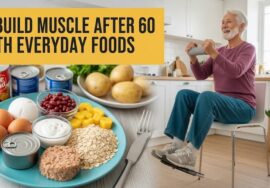Table of Contents
- Introduction
- Why Seniors Face Blood Sugar Challenges in the USA
- A Hollywood Reminder: Tom Hanks’ Story
- 7 Natural Blood Sugar Hacks for Seniors
- Lifestyle Habits That Reinforce These Hacks
- Final Thoughts
- Frequently Asked Questions (Google Discover Optimized)
Introduction
Pharmacy shelves in America are crowded with pills and powders promising better blood sugar control. But many older adults still ask a fair question: Can simple habits calm my numbers without one more prescription bottle?

The answer is often yes. Here are seven doable routines that don’t require fancy equipment or complicated diets—just everyday choices that fit naturally into life.
Why Seniors Face Blood Sugar Challenges in the USA
With age, the body shifts. Muscle mass thins out, metabolism slows, and it’s easy to spend long stretches sitting. Toss in processed meals or quick drive-through dinners, and even “ordinary” foods can cause sugar to swing up and down.

That said, the solution isn’t dramatic. A few consistent tweaks—hydration, steady meals, light activity—can tip the balance back in your favor.
A Hollywood Reminder: Tom Hanks’ Story
In 2013, Tom Hanks went on The Late Show with David Letterman and revealed that he had type 2 diabetes. He admitted he had ignored warning signs for years until his doctor finally gave him the diagnosis.

Hanks didn’t just depend on medication. He worked on everyday changes—managing his weight, choosing foods more carefully, and paying closer attention to his lifestyle. His honesty is a reminder: blood sugar issues don’t skip the rich or famous, and simple, steady habits matter for everyone.
(More on his story at Today.com).
7 Natural Blood Sugar Hacks for Seniors
Hack 1: Morning Hydration Reset
Before coffee or breakfast, sip a glass of warm water with lemon. Overnight, the body dries out, and that mild dehydration can bump glucose higher than it should be. This small ritual refreshes your system and makes the morning easier.
(See Harvard Health on hydration and aging.)

Hack 2: Cinnamon Daily Boost
Choose Ceylon cinnamon—the softer, lighter version of cinnamon. Studies suggest it can improve how the body handles glucose. A sprinkle over oatmeal, tea, or yogurt is an easy habit to keep, and over time it may help flatten those after-meal surges.
(Research overview: NIH)

Hack 3: Slow Carb Breakfast Choices
Skip the sugar cereal crash. Instead, try steel-cut oats, chia pudding, or Greek yogurt. These foods digest slowly, releasing energy in a steady stream so you don’t hit that mid-morning slump.

👉 Related: What Are the Main Health Benefits of Chia Seeds
Hack 4: Gentle Chair Exercises After Meals
An hour after eating, sugar usually peaks. Moving your muscles—even just 10 minutes of seated leg lifts, ankle rolls, or slow hallway laps—pulls glucose from the blood and keeps numbers from climbing too high.

Hack 5: Apple Cider Vinegar Evening Trick
Mix a teaspoon of apple cider vinegar in warm water before dinner. It slows down how quickly carbs like bread or pasta turn into sugar, so your levels rise more gradually. If the tart taste bothers you, add a touch of honey to smooth it out.

Hack 6: Magnesium-Rich Greens Snack
Magnesium often runs low in older adults, and without it, glucose is harder to control. A handful of pumpkin seeds, a few almonds, or a serving of spinach adds back this mineral while supporting heart and bone health.

Hack 7: Bedtime Herbal Tea Routine
If restless nights are familiar, it could be sugar swings. A warm cup of chamomile or cinnamon tea before bed helps the body relax and keeps levels steadier overnight. It’s a simple way to close the day on a calmer note.

Lifestyle Habits That Reinforce These Hacks
- Eat on a regular schedule.
- Make half your plate vegetables or fruit.
- When stress shows up, pause to stretch or breathe.
- Aim for seven to eight hours of sleep most nights.
These basics make the seven hacks even more effective.
Final Thoughts
Tom Hanks’ confession hit headlines because it showed how common these issues are. But what mattered most was what he did next: small changes, done daily, that made the difference. For seniors across the U.S., the same approach can keep sugar steady without piling on new prescriptions.
Frequently Asked Questions (Google Discover Optimized)
Q1. Can seniors manage blood sugar naturally?
Often yes. Habits like steady hydration, slow-carb breakfasts, and short movement breaks can shift numbers in the right direction.
Q2. Is cinnamon safe every day?
Most people do fine with ½–1 teaspoon of Ceylon cinnamon daily. If you take medications, check first with your doctor.
Q3. Does apple cider vinegar work quickly?
Don’t expect an overnight fix. Many people notice steadier readings after a few weeks of consistent use.
Q4. Why start the morning with water?
Because sleep dehydrates you. Rehydrating before breakfast keeps early glucose from spiking too high.
Q5. What if I can’t walk after meals?
Seated stretches—like ankle circles or knee lifts—work too. The muscle activity is what helps.
Q6. How does magnesium affect sugar?
It supports insulin’s work. Foods like pumpkin seeds, almonds, and leafy greens are easy ways to get more.
Q7. Is bedtime tea safe for seniors?
Chamomile and cinnamon teas are caffeine-free. If you take sedatives or sleep aids, check with your provider first.
Q8. Do slow-carb breakfasts really help?
Yes. Foods like oats or chia pudding digest slowly, so your energy lasts longer and sugar stays steadier.
Q9. Should I stop my medications if I try these hacks?
No. Keep following your treatment plan and talk to your doctor before making any changes.
Q10. How soon will I notice results?
Many seniors report feeling more energetic and seeing steadier numbers after two to four weeks.








